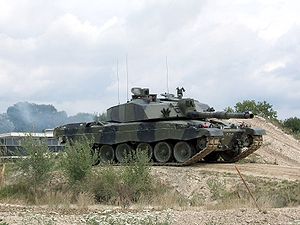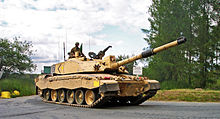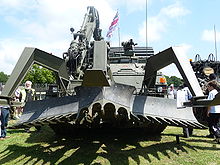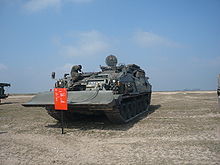- Challenger 2
-
FV 4034 Challenger 2 
Challenger 2 on manoeuvres on Salisbury PlainType Main battle tank Place of origin  United Kingdom
United KingdomService history In service 1998–present Used by British Army, Oman Army Wars Iraq War Production history Manufacturer Alvis Vickers Unit cost ~£4,217,000
~$6,797,660
[1]Produced 1993–2002 Number built ~446 Specifications Weight 62.5 tonnes (61.5 long tons; 68.9 short tons) Length 8.3 m (27 ft 3 in) 11.50 m (37 ft 9 in) with gun forward
Width 3.5 m (11 ft 6 in) 4.2 m (13 ft 9 in) with appliqué armour
Height 2.5 m (8 ft 2 in) Crew 4 (commander, gunner, loader/operator, driver) Armour Chobham/Dorchester Level 2 (classified) Main
armamentL30A1 120 mm rifled gun
with 52 roundsSecondary
armamentCoaxial 7.62 mm L94A1 EX-34 (chain gun),
7.62 mm L37A2 Commander's cupola machine gunEngine Perkins CV-12 Diesel
1,200 hp (890 kW)Power/weight 19.2 hp/t (14.3 kW/t) Transmission David Brown TN54 epicyclic transmission (6 fwd, 2 rev.) Suspension Hydropneumatic Ground clearance 0.5 m (1 ft 8 in)[2] Fuel capacity 1,592 litres (350 imp gal; 421 US gal)[2] Operational
range450 km (280 mi)[2] road
250 km (160 mi)[2] off roadSpeed 56 km/h (35 mph)[2] 40 km/h (25 mph)[2] off road
Post-WWII British AFVsWheeled Ferret Scout Car · Fox Reconnaissance Vehicle · Saladin Armoured Car · Saracen APC · FV1611 "Pig" · Saxon · Mastiff PPV · Husky TSVAPCs and IFVs Light tanks and
anti-tank vehiclesSP artillery Main battle tanks UK unarmoured or non-fighting vehiclesPost-Cold War tanks- List
- Category
Under 120 mm gun
Under 50 tonnes
- Al-Zarrar
- Al-Khalid
- P'okpoong-Ho
- PT-91 Twardy
- T-84
- T-90
- Type 96
- Zulfiqar
Not in service
- Altay
- Black Eagle
- EE-T1 Osório
- K2 Black Panther
- M60-2000
- M-95 Degman
- M-84AS
- T-95
- Tank EX
- Type 10
- Type 99KM
FV4034 Challenger 2 is a British main battle tank (MBT) currently in service with the armies of the United Kingdom and Oman. It was designed and built by the British company Vickers Defence Systems (now known as BAE Systems Land and Armaments). The manufacturer advertises it as the world's most reliable main battle tank.[3] As of January 2011[update], only three Challenger 2s have been damaged in combat, one of which was destroyed by another Challenger 2 in a friendly fire incident.
Challenger 2 is an extensive redesign from Challenger 1, the MBT from which it was developed. It uses the basic hull and automotive parts of its predecessor but all other components are new. Fewer than 5% of components are interchangeable. Challenger 2 has now replaced Challenger 1 in service with the British Army and is also used by the Royal Army of Oman. It has seen operational service in Bosnia, Kosovo and Iraq. During the 2003 invasion of Iraq the Challenger 2 tanks operating in the Gulf suffered no losses to enemy fire.
Contents
History
 Challenger 2 Tank of the Royal Scots Dragoon Guards (Squadron D) during live fire training exercises on Bergen-Hohne Training Area (Germany).
Challenger 2 Tank of the Royal Scots Dragoon Guards (Squadron D) during live fire training exercises on Bergen-Hohne Training Area (Germany).
Challenger 2 is the third vehicle of this name, the first being the A30 Challenger, a Second World War design using the Cromwell tank chassis with a 17-pounder gun. The second was the Persian Gulf War era Challenger 1, which was the British army's main battle tank (MBT) from the early 1980s to the mid-1990s.Vickers Defence Systems (later Alvis Vickers, now BAE Systems Land Systems) began to develop a successor to Challenger 1 as a private venture in 1986. Following the issue of a Staff Requirement for a next-generation tank, Vickers formally submitted its plans for Challenger 2 to the Ministry of Defence (MoD). Secretary of State for Defence George Younger announced to the House of Commons that Vickers would receive £90 million contract for a demonstrator vehicle, a deal that was finalised in January 1989.[4] The demonstration phase contained three milestones for progress, with dates of September 1989, March 1990, and September 1990. At the last of these milestones, Vickers was to have met 11 key criteria for the tank's design.[4]
In June 1991, after competition with other tank manufacturers' designs (including the M1A2 Abrams and the Leopard 2 (Improved)), the MoD placed a £520 million order for 127 MBTs and 13 driver training vehicles. An order for a further 259 tanks and 9 driver trainers (worth £800 million) was placed in 1994. Oman ordered 18 Challenger 2s in 1993 and a further 20 tanks in November 1997.
Production began in 1993 at two primary sites: Elswick, Tyne and Wear and Barnbow, Leeds, although over 250 subcontractors were involved. The first tanks were delivered in July 1994.
The Challenger 2 successfully completed its Reliability Growth Trial in 1994. Three vehicles were tested for 285 simulated battlefield days. Each day is known to have consisted of:
- 27 km (17 mi) of on-road travel
- 33 km (21 mi) of off-road travel
- 34 main armament rounds fired
- 1,000 7.62 MG rounds fired
- 16 hours weapon system operation
- 10 hours main engine idling
- 3.5 hours main engine running
An equally important milestone was the In-Service Reliability Demonstration (ISRD) in 1999. 12 fully crewed tanks were tested at the Bovington test tracks and at Lulworth Bindon ranges. The tank exceeded all staff requirements.
Challenger 2 entered service with the British Army in 1998 (with the Royal Scots Dragoon Guards in Germany), with the last delivered in 2002. It is expected to remain in service until 2035. It serves with the Royal Scots Dragoon Guards, the Royal Dragoon Guards, the Queen's Royal Hussars, the King's Royal Hussars and the 2nd Royal Tank Regiment, each of which is the tank unit of an armoured or a mechanised brigade. One squadron of the 1st Royal Tank Regiment uses Challenger 2 in a training and demonstration role.
Deliveries of the Challenger 2 to Oman were completed in 2001.
The Trojan minefield breaching vehicle and the Titan bridge-laying vehicle based on the chassis of the Challenger 2 were shown in November 2006; 66 are to be supplied by BAE Systems to the Royal Engineers, at a cost of £250 million.[5]
A British military document from 2001 indicated that the British Army would not procure a replacement for the Challenger 2 because of a lack of conventional threats in the foreseeable future.[6]
Design
Armament
Challenger 2 is equipped with a 120 millimetres (4.7 in) 55 calibre long L30A1 tank gun,[7] the successor to the L11 gun used on Chieftain and Challenger 1. The gun is made from high strength Electro Slag Remelting (ESR) steel with a chromium alloy lining and, like earlier British 120 mm guns, it is insulated by a thermal sleeve. It is fitted with a muzzle reference system and fume extractor, and is controlled by an all-electric control and stabilization system. The turret has a rotation time of 9 seconds through 360 degrees.
Uniquely among NATO main battle tank armament, the L30A1 is rifled, because the British Army continues to place a premium on the use of high explosive squash head (HESH) rounds in addition to APFSDS armour-piercing rounds. HESH rounds have a longer range (up to 8 kilometres / 5 miles) than APFSDS, and are more effective against buildings and thin-skinned vehicles.
Forty-nine main armament rounds are carried in the turret and hull; these are a mix of L27A1 APFSDS (also referred to as CHARM 3), L31 HESH and L34 white phosphorus smoke rounds, depending on the situation. As with earlier versions of the 120 mm gun, the propellant charges are loaded separately from the shell or KE projectile. A combustible rigid charge is used for the APFSDS rounds, and a combustible hemispherical bag charge for the HESH and Smoke rounds. An electrically-fired vent tube is used to initiate firing of the main armament rounds. (The main armament ammunition is thus described to be "three part ammunition", consisting of the projectile, charge and vent tube.)
The Challenger 2 is also armed with a L94A1 EX-34 7.62 mm chain gun coaxially to the left of the main gun, and a 7.62 mm L37A2 (GPMG) machine gun mounted on a pintle on the loader's hatch ring. 4,200 rounds of 7.62 mm ammunition are carried.
Fire control and sights
The digital fire control computer from Computing Devices Co of Canada contains two 32-bit processors with a MIL STD1553B databus, and has capacity for additional systems, for example a Battlefield Information Control System.
The commander has a panoramic SAGEM VS 580-10 gyrostabilised sight with laser rangefinder. Elevation range is +35° to −35°. The commander's station is equipped with eight periscopes for 360° vision.
The Thermal Observation and Gunnery Sight II (TOGS II), from Thales, provides night vision. The thermal image is displayed on both the gunner's and commander's sights and monitors. The gunner has a stabilised primary sight using a laser rangefinder with a range of 200 m to 10 km. The driver's position is equipped with a Thales Optronics image-intensifying Passive Driving Periscope (PDP) for night driving.
Defence
Challenger 2 is one of the most heavily armoured and best protected tanks in the world.[8] The turret and hull are protected with second generation Chobham armour (also known as Dorchester) the details of which are still classified. The military claims that this material is twice as strong as steel.[citation needed] Explosive reactive armour (ERA) kits are also fitted as necessary. The nuclear, biological and chemical (NBC) protection system is located in the turret bustle.
On each side of the turret are five L8 smoke grenade dischargers. Challenger 2 can also create smoke by injecting diesel fuel into the exhaust manifolds.
Drive system
 A Challenger 2 practising on Salisbury Plain
A Challenger 2 practising on Salisbury Plain
- Engine: Perkins 26.6 litre CV12 diesel engine delivering 1,200 hp (890 kW).
- Gearbox: David Brown TN54 epicyclical transmission (6 fwd, 2 rev.).
- Suspension: second-generation hydrogas.
- Track: William Cook Defence hydraulically adjustable double-pin.
- Maximum speed: 37 mph/60 km/h (road); 25 mph/40 km/h (cross country)
- Range: 280 mi/450 km (road); 156 mi/250 km (cross country).
Crew and accommodation
The British Army maintained its requirement for a four-man crew (including a loader) after risk analysis of the incorporation of an automatic loader suggested that auto-loaders reduced battlefield survivability. Mechanical failure and the time required for repair were prime concerns.
Like every British tank since the Centurion, and most other British AFVs, Challenger 2 contains a boiling vessel (BV) also known as a kettle or bivvie for water which can be used to brew tea, produce other hot beverages and heat boil-in-the-bag meals contained in ration packs.[9] This BV requirement is general for armoured vehicles of the British Armed Forces, and is unique to the armed forces of the UK.
Operational usage
[The tank was] "well armoured but in an operational theatre it's not the case that you can have absolute protection. This was not in any way new technology - the device involved was the same type of shaped charge that we have seen used very regularly. No-one has ever said Challenger tanks are impenetrable. We have always said that a big enough bomb will defeat any armour and any vehicle."
MOD Spokesman, speaking in regard to the Challenger 2[10]Challenger 2 had already been used in peacekeeping missions and exercises before but its first combat use came in March 2003 during the invasion of Iraq. 7th Armoured Brigade, part of 1st Armoured Division, was in action with 120 Challenger 2s around Basra. The tanks saw extensive use during the siege of Basra, providing fire support to the British forces. The tank's availability was excellent and the problems that were identified during the large Saif Sareea II exercise, which took place eighteen months earlier, were solved by the issuing of Urgent Operational Requirements for equipment such as sand filters.
In one encounter within the urban area a Challenger 2 came under attack from irregular forces with machine guns and rocket propelled grenades. The driver's sight was damaged and while attempting to back away under the commander's directions, the other sights were damaged and the tank threw its tracks entering a ditch. It was hit directly by fourteen rocket propelled grenades from close range and a MILAN anti-tank missile.[11] The crew survived remaining safe within the tank until the tank was recovered for repairs, the worst damage being to the sighting system. It was back in operation six hours later after repairs. One Challenger 2 operating near Basra survived being hit by 70 RPGs in another incident.[12]
There have been two Challenger 2s damaged in combat and one destroyed:- A friendly fire ("blue-on-blue") incident on 25 March 2003 in Basra in which one Challenger 2 of the Black Watch Battlegroup (2nd Royal Tank Regiment) mistakenly engaged another Challenger 2 of the Queen's Royal Lancers after detecting what was believed to be an enemy flanking manoeuvre on thermal equipment. The attacking tank's second HESH round hit the open commander's hatch lid of the QRL tank sending hot fragments into the turret that caused an explosion of the stowed ammunition, destroying the tank and killing two crew members. It remains the only Challenger 2 to be completely destroyed on operations.[13]
- August 2006 - the driver of a Challenger 2, Trooper Sean Chance, lost three of his toes when an RPG-29 penetrated an ERA protected frontal part of the hull during an engagement in al-Amarah, Iraq.[14]
- April 6, 2007 - in Basra, Iraq, an IED shaped charge penetrated the underside of the tank resulting in the driver losing a leg and causing minor injuries to another soldier.[15]
To help prevent incidents of this nature happening again, Challenger 2s have been upgraded with a new passive armour package, including the use of add-on armor manufactured by Rafael Advanced Defense Systems of Israel.[16] When deployed on operations the Challenger 2 is now normally upgraded to TES (Theatre Entry Standard), this includes a number of modifications including armour and weapon system upgrades.
Upgrades and variants
CLIP
An upgraded Challenger II with added explosive reactive armor panels, manufactured by Rafael Advanced Defense Systems.[16]
The Challenger Lethality Improvement Programme (CLIP) is a programme to replace the current L30A1 rifled gun with the 120 mm Rheinmetall L55 smoothbore gun currently used in the Leopard 2A6. The use of a smoothbore weapon allows Challenger 2 to use NATO standard ammunition developed in Germany and the US. This includes tungsten-based kinetic energy penetrators, which do not have the same political and environmental objections as depleted uranium rounds. The production lines for rifled 120 mm ammunition in the UK have been closed for some years, so existing stocks of ammunition for the L30A1 are finite.[17]
A single Challenger 2 was fitted with the L55 and underwent trials in January 2006.[18] The smoothbore gun is the same length as the L30A1, and is fitted with the rifled gun's cradle, thermal sleeve, bore evacuator and muzzle reference system. Early trials apparently revealed that the German tungsten DM53 round was more effective than the depleted uranium CHARM 3.[8] The ammunition storage and handling arrangements will need to be changed to cater for the single-piece smoothbore rounds, instead of the separate-loading rifled rounds. In 2006, a figure of £386 million was estimated to fit all Challengers in the British Army with the Rheinmetall gun.[17]
Other improvements have also been considered, including a regenerative NBC protection system.[19]
In May 2007, the Ministry of Defence's Future Systems Group invited BAE to tender for the Challenger 2 Capability Sustainment Program (C2 CSP), which combined all upgrades into one programme. However, by mid-2008, the programme was in danger of slipping, or even being cancelled, as a result of defence budget shortfalls.[20]
Titan
The Titan armoured bridge layer is based on aspects of the Challenger 2 running gear and will replace the Chieftain Armoured Vehicle Launched Bridge (ChAVLB). The Titan came into service in 2006 with the Royal Engineers, with 33 in service. Titan can carry a single 26 metre long bridge or two 12 metre long bridges. It can also be fitted with a bulldozer blade.
Trojan
Main article: Trojan (vehicle)Trojan is a combat engineering vehicle, styled as an AVRE for Armoured Vehicle, Royal Engineers in British Army parlance, designed as a replacement for the Chieftain AVRE (ChAVRE). It uses the Challenger 2 chassis, and will carry an articulated excavator arm, a dozer blade, and attachment rails for fascines. Like Titan, 33 are intended to reach service.
Challenger 2E
Challenger 2E is an export version of the tank. It has a new integrated weapon control and battlefield management system, which includes a gyrostabilised panoramic SAGEM MVS 580 day/thermal sight for the commander and SAGEM SAVAN 15 gyrostabilised day/thermal sight for the gunner, both with eyesafe laser rangefinder. This allows hunter/killer operations with a common engagement sequence. An optional servo-controlled overhead weapons platform can be slaved to the commander's sight to allow operation independent from the turret.
The power pack has been replaced with a new 1,500 hp (1,100 kW) EuroPowerPack with transversely mounted MTU MT 883 diesel engine coupled to Renk HSWL 295TM automatic transmission. The increase in vehicle performance is significant. The smaller volume but more powerful power pack incorporates as standard a cooling system and air-intake filtration system proved in desert use. The free space in the hull is available for ammunition stowage or for fuel, increasing the vehicle’s range to 550 km.
BAE announced in 2005 that development and export marketing of 2E would stop. This has been linked by the media to the failure of the 2E to be selected for the Hellenic Army in 2002, a competition won by the Leopard 2.[21]
CRARRV
The Challenger Armoured Repair and Recovery Vehicle (CRARRV) is an armoured recovery vehicle based on the Challenger hull and designed to repair and recover damaged tanks on the battlefield. It has five seats but usually carries a crew of three soldiers from the Royal Electrical And Mechanical Engineers (REME), of the Vehicle Mechanic and Recovery Mechanic trades. There is room in the cabin for two further passengers (e.g. crew members of the casualty vehicle) on a temporary basis.
The size and performance are similar to the MBT, but instead of armament it is fitted with:
- A main winch with 54-tonne pull (can exert 100 tonnes-force using an included pulley and anchor point on the vehicle), plus a small pilot winch to aid in deploying the main cable.
- Atlas crane capable of lifting 6,500 kg at a distance of 4.9 m (this is sufficient to lift a Challenger 2 power pack).
- In order to improve the flexibility and supplement the transportation power packs around the battlefield, the British Army procured a quantity of dedicated CRARRV High Mobility Trailers (CRARRV HMT). Each CRARRV HMT enables a CRARRV to transport a single (Challenger, Titan or Trojan) power pack or two Warrior power packs by altering the configuration of dedicated fixtures and attachment of fittings.
- Dozer blade to act as an earth anchor/stabiliser, or in obstacle clearance and fire position preparation.
- Large set of recovery and heavy repair tools including compressed air powered tools and arc-welding capability.
The design prototype is on display at The REME Museum of Technology in Arborfield, Berkshire.
Operators
 United Kingdom - British Army 408 delivered
United Kingdom - British Army 408 delivered Oman - Royal Army of Oman 38 delivered
Oman - Royal Army of Oman 38 delivered
See also
- List of armoured fighting vehicles
- Chobham armour
Notes
- ^ "Challenger 2". armedforces.co.uk. http://www.armedforces.co.uk/army/listings/l0023.html. Retrieved 2011-01-16.
- ^ a b c d e f Foss, Chris. Jane's Armour and Artillery 2005-2006. Jane's Information Group. p. 143. ISBN 071062686X.
- ^ "Products & Services Challenger 2". BAE Systems. 2008-02-14. http://www.baesystems.com/ProductsServices/l_and_a_ls_challenger.html. Retrieved 2011-01-16.
- ^ a b Challenger 2 Main Battle Tank 1987-2006 By Simon Dunstan, Tony Bryan, page 5
- ^ Trojan and Titan Armoured Engineer Vehicles armedforces.co.uk
- ^ Gender, War, and Militarism: Feminist Perspectives. ABC-CLIO. 2010. pp. 40. ISBN 978-0-313-39143-9. http://books.google.com/books?id=om3yy1JoS34C&vq=isbn&dq=%22Main+battle+tank%22&source=gbs_navlinks_s. Retrieved 3 July 2011.
- ^ "Vickers Defence Systems Challenger 2 MBT". Archived from the original on Aug 04, 2004. http://web.archive.org/web/20040804224012/http://www.janes.com/defence/land_forces/news/misc/jaa_challenger2_mbt.shtml.
- ^ a b "Main Battle Tank - Challenger 2". Fprado.com. http://www.fprado.com/armorsite/chall2.htm. Retrieved 2011-01-16.
- ^ Audrey Gillan. A brew brings coalition forces closer together, Guardian Unlimited, 7 April 2003
- ^ "Iraq bombing damages British tank". BBC News. 23 April 2007. http://news.bbc.co.uk/1/hi/world/middle_east/6583607.stm.
- ^ "Dragoon guards survive ambush". BBC News. 2003-04-02. http://news.bbc.co.uk/2/hi/uk_news/scotland/2908679.stm. Retrieved 2011-01-16.
- ^ "Tanks and artillery 'face MoD axe'". BBC News. 2003-04-03. http://news.bbc.co.uk/1/hi/uk/2905817.stm. Retrieved 2011-01-16.
- ^ "UK Ministry of Defence : Army Board of Inquiry Report" (PDF). http://www.mod.uk/NR/rdonlyres/C2384518-7EBA-4CFF-B127-E87871E41B51/0/boi_challenger2_25mar03.pdf. Retrieved 2011-01-16.
- ^ "Defence chiefs knew 'invincible' tank armour could be breached". Daily Mail (London). 24 April 2007. http://www.dailymail.co.uk/pages/live/articles/news/news.html?in_article_id=450477&in_page_id=1770.
- ^ Foster, Patrick (April 23, 2007). "Improvised bomb hits British tank". The Times. http://www.timesonline.co.uk/tol/news/world/iraq/article1691220.ece.
- ^ a b British Next Generation Armour, Tankograd British Special no. 9009, Dan Hay
- ^ a b "ForecastInternational" (doc). http://www.forecastinternational.com/archive/or/vo0190.doc. Retrieved 2009-08-08.
- ^ Army Technology.com
- ^ Foss, Christopher F. "UK fields regenerative NBC system". Jane's Defence News. Archived from the original on May 27, 2008. http://web.archive.org/web/20080527151434/http://www.janes.com/defence/news/jdw/jdw060329_2_n.shtml.
- ^ "Military Vehicles Forecast" (PDF). http://mc.nstl.gov.cn/pages/2009/86/01/(2).pdf. Retrieved 2009-08-08.
- ^ Challenger nears end of the line - Jane's Land Forces News[dead link]
References
- Rayment, Sean (12 May 2007). "MoD kept failure of best tank quiet". telegraph.co.uk (London: Daily Telegraph). http://www.telegraph.co.uk/news/main.jhtml?xml=/news/2007/05/13/nmod13.xml. Retrieved 2007-08-09. "One of the British Army's Challenger 2 tanks was pierced by an Iraqi insurgent missile more than eight months earlier than the Government has previously admitted"
- "Fact file: Challenger 2". BBC News. 7 January 2003. http://news.bbc.co.uk/2/hi/uk_news/2519005.stm. Retrieved 2008-07-09.
- Houston, Simon (2 April 2003). "Dragoon guards survive ambush". Daily Record (BBC News). http://news.bbc.co.uk/2/hi/uk_news/scotland/2908679.stm. Retrieved 2008-09-14.
External links
- British army Challenger II webpage
- The ARMOR Site! page on Challenger 2
- Challenger 2 and images on Armour.ws
- Army-Technology
Post-WWII British AFVsWheeled Ferret Scout Car · Fox Reconnaissance Vehicle · Saladin Armoured Car · Saracen APC · FV1611 "Pig" · Saxon · Mastiff PPV · Husky TSVAPCs and IFVs Light tanks and
anti-tank vehiclesSP artillery Main battle tanks UK unarmoured or non-fighting vehiclesCategories:- Main battle tanks of the United Kingdom
- Main battle tanks of the post–Cold War period
- Royal Armoured Corps
- Main battle tanks of the Iraq War
Wikimedia Foundation. 2010.






